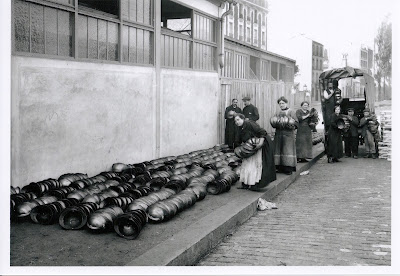Excerpt from: Helmets and Body Armor in Modern Warfare by Bashford Dean, Yale University Press, 1920:
The French appear to be the first to accept the helmet in actual service and thousands of soldiers today bear witness to the practical value of the casque which was provided for them, notably through the efforts of General Adrian.
A few words as to the work of General Adrian... General Adrian sought ways and means in all directions for reducing his losses. One day he stood before a stretcher and talked with a wounded man --- "I had luck," said the sufferer, "I happened to have a metal mess-bowl in my hat and it saved my life." This incident impressed the General deeply. Here was the question of a device which might prove of universal value. So with his usual earnestness, he attacked the problem of a head defense. He promptly had a steel "calotte" made and fitted inside his cap; then he wore it constantly to find whether it would cause notable discomfort. Next he had many of them made and used experimentally.
Good reports soon came in from the front. Thereupon, he developed the regular helmet which was manufactured in great numbers for the French Army. At first this defense was turned out hastily, stamped from dies which had already served in making the helmets of firemen.
Investigation showed that the new helmet was of actual value in the field; hence it became a part of the regular equipment and was used by every soldier on active duty...
It is interesting to note that almost from the beginning the "casque Adrian" was a successful experiment. It protected a measurable portion of its wearer; it was light and soldiers of all classes shortly "took to it." The casque was attractive in its lines and it added martial distinction to its wearer - which proved, in the opinion of many officers, a more important argument for its use than its ballistic value.
French General August Louis Adrian made the battlefield a safer place for the soldier when he designed the first modern combat helmet (click the link for the video).
The French armed forces appeared on the field in the opening year of the Great War uniformed much as they had been fifty years earlier. Pomp and prettiness by the yard, but very little functionality either in personal protection or concealment.
Side view, showing both the distinctive profile of this beautiful helmet and , at the same time, exposing its inherent weaknesses. The helmet consists of four separate parts: front visor, rear visor, bowl, and crest. Each seam and each rivet represents a weak point, a place of potential failure. This helmet is very light, the steel very thin, the liner rudimentary, and the whole thing is made of only mild steel, still...
it was a breakthrough, and immediately fatalities from head wounds decreased.
The only way for protective equipment to be successful is if it is actually used. The French high command was pleasantly surprised with the enthusiasm that the French G.I.s accepted this helmet. It provided them with a martial élan, that stoked their professionalism and pride. In short, the French soldiers embraced it.
And the other nations took note.
The "flaming bomb" is the symbol of the infantry...
this is much like the insignia of the US Army Ordnance Corps.
A critical weak point on this helmet, where the bowl and the front and rear visors
are joined together by rivets.
This close-up of the leather, wool, and metal liner demonstrate another weakness of this pioneer attempt a cranial protection: corrugated aluminum spacers provide less than a quarter of an inch separating the shell of the helmet from the skull of the wearer. Typical displacement of a dent in the helmet is an inch...so where does that leave the skull of the wearer? Improvements will come, but, still, this is much better than a cloth cap, ne conviendriez-vous pas ?
Manufacture of the helmet was a combination of machine and hand-work, and saw the employment of many female war-workers.

Multiple stampings form the bowl-shaped shell.
Visible are the crimped edges which will accept the front and rear visors.
Here, the crests have yet to be added showing to good effect the ventilation hole
at the crown of the shell
Assembling the liners. These are the earlier one-piece versions. Later in the war, in a move to conserve leather the ends of the leather fingers were separate pieces, allowing the manufacture to utilize leftover portions of leather.
Ready for shipment, and...
et voilà!
Now, for some action shots.
1,357,800 dead, 4,266,000 wounded.
Before you go, check out the delightful label of this California winery, with the model 1915 as its logo. How cool is that?
Link to Le Casque here, and raise a glass of this fine California wine in a toast to General August Louis Adrian, the man who started it all. Cheers!
See you next time with another cool helmet from the collection.
Mannie
Mannie








































1 comment:
I believe Winston Churchill wore an Adrian when he commanded a battalion in the trenches, favoring it over the British helmet.
Post a Comment